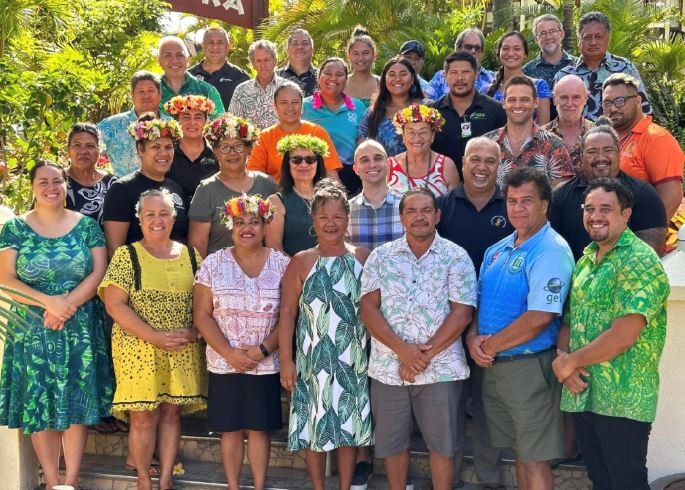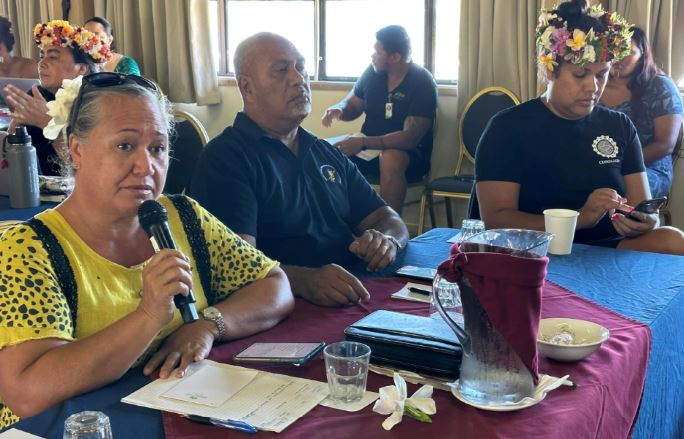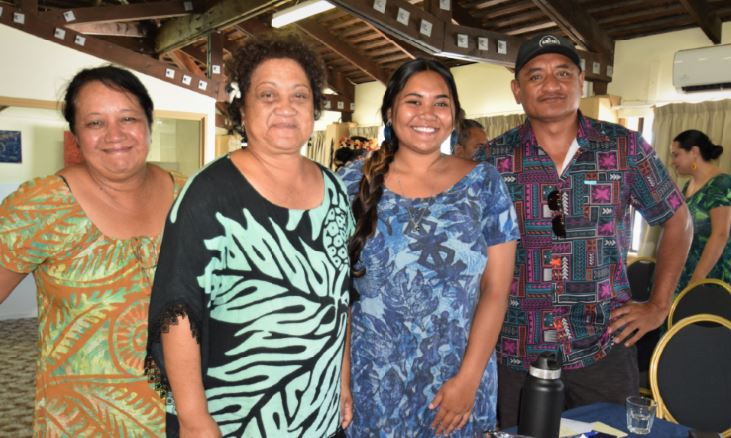Understanding locally protected areas
Thursday 26 January 2023 | Written by Melina Etches | Published in Environment, National

The participants at the Other Effective Area-based Conservation Measures (OECM) workshop held over two days at The Edgewater Resort. SPREP/23012528
Committed to achieving 25 per cent of Cook Islands land as a protected area under National Sustainable Development Agenda 2020+, the first ever ‘Other Effective Area-based Conservation Measures’ (OECM) workshop came to a close on Wednesday.
Established Protected Areas in the Cook Islands include the Suwarrow National Park and 50 nautical miles around each island under the Marae Moana Act 2017.
However, the National Environment Services (NES) environment partnerships manager, Hayley Weeks said: “It is known that we have a lot of traditional methods to conserve areas.”
Following the two-day workshop, NES can start to review the locally managed conservation areas and whether they can potentially fit the OECM category.
Weeks said: “It’s great that we are the first in the region to undertake this activity – that’s a tribute to the great work that’s already been done here and acknowledgement of that work. It will be really good if we can demonstrate to the region how that can be recognised and supported.”
There are many areas in the Cook Islands that are locally considered to be protected areas. But when looking at international definitions that were guided by in the Treaties that the Cook Islands are a party to, “in some cases they don’t meet that international criteria”, explained Weeks.

Tapuatua (Maine) Wichman - Tiaki Taonga o Kaena Mataiapo Tutara, says “we do have a lot of areas that aren’t protected”. SPREP/23012527
Part of the exercise of the workshop was to see how NES aligned with what is recognised locally to be a protected area with its international definition.
In many cases they don’t align, says Weeks, adding NES still want to find ways to recognise and acknowledge all the good conservation work that has been done.
For most cases, protected areas are traditionally and locally established by the Aronga Mana, the communities or private landowners, for example, the “raui” tradition and the Takitumu Conservation Area (TCA).
“It has been recognised over recent years that not everything falls into protected area and so another category like the OECMs was created to try and acknowledge those areas that don’t fit the protected area definition but still have positive conservation value,” said Weeks.
The OCEMs can be of benefit to the Cook Islands because there are a lot of local areas that don’t fit a strict protected area definition but may qualify as a potential OECM, she adds.
“So, its good in that respect because it will help us, we already identify these sites locally but it helps us acknowledge them for the work that’s being done and with that it can potentially unlock resources to help them.
“The more that we have these areas documented and recognised it helps us try and access additional resources to support them,” Weeks said.
Tapuatua (Maine) Wichman – Tiaki Taonga o Kaena Mataiapo Tutara – said: “Given that we do have a lot of areas that aren’t protected but from the definition of protected areas, it seems that we have a lot of areas outside of that definition, so where would they fall?”
During the workshop Wichman saw that the OCEMs is another mechanism in place to recognise these “other areas” that do not fit in the international protected areas category.
“Our culturally significant areas, a lot of them are not protected, they might be protected in our minds. As Maori they might be protected and understood between Maori that they are protected, for example the marae,” said Wichman.
“Maori understand that there are a lot of things you cannot do on the marae even as simple as who goes on the marae, therefore that would imply that there is a protection in place, but none of this is legal language, therefore, it doesn’t come under the ‘protected’.
“Being a protected area is relative, relative to its definition…”
Understanding people are very much part of the land, adds Wichman. “You don’t own it, but you are responsible for it and you’ve got to be able to hand it over to the next generation in the same condition, if not better.”
Concerns were raised that the workshop may be just another programme full of promises “that don’t filter down to the real people” and Wichman believes the assessment standard needs to have a local understanding to it.

Ngatuaine Maui (left), Justina Nicholas, Eva Patai and Dr Teina Rongo at the Other Effective Area-based Conservation Measures (OECMs) workshop. 23012408
Wichman commended those who have put together the programme and appreciated the authors, but said “only those of a particular background understand the terminology, but the people they are reaching out to, do not.”
The Tauranga Vananga Ministry of Culture national identity director, Ngatuaine Maui said the OCEMs would be beneficial to some degree. However, during some discussions in regards to “raui” areas, she said “the sentiment is no, people really don’t want laws to restrict them and people feel it is better as it is now”.
“Sometimes our customary raui ways are the best form of protection because we know when to harvest, what the seasons are and just by knowing that, we don’t exploit it…”
Maui doesn’t think more legislation or regulations will strengthen locally protected areas.
“But it is good that this is offered and maybe there will be one or two areas that will fit into this category (OCEMs), it’s been an eyeopener letting us know what else is there.”
According to the organisers, the workshop will result in an improved understanding of OECMs among conservation practitioners and policymakers, and gain an insight into potential OECMs and concerns specific to the Cook Islands and the Pacific region.
It will also help plan a way forward to recognise and report OECMs in the Cook Islands.
Director of National Environment Service, Halatoa Fua said: “When it comes to biodiversity, as a global community we are failing. Our marine species are impacted by marine plastic pollution which has increased tenfold since 1980, in the last 20 years our planet has lost approximately 420 million hectares of forest, and invasive species has been the cause of close to 40 per cent of all animal extinctions.”
“What is happening across our planet is happening here to us also, and we’re pleased to be playing a proactive role to protect and conserve. The Cook Islands are taking the right, positive steps, doing what we can to provide solutions for this global crisis.”
Currently there are no OECMs registered in the Pacific. Endorsed in December 2022, the Global Biodiversity Framework (GBF) has 23 targets under four overarching goals to be met by over 195 countries, including the Cook Islands.
The OECM workshop was held at the Edgewater Resort, supported by the EU-OACPS BIOPAMA programme and its partners – IUCN Oceania, the Secretariat of the Pacific Regional Environment Programme (SPREP) and the UN Environment Programme -World Conservation Monitoring Centre (UNEP-WCMC) in partnership with the Cook Islands National Environment Service.




















































